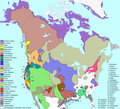List of language families
Spoken language families
- Traditional geographical classification (not implying genetic relationship)
Legend
Sign language families
The family relationships of sign languages are not well established due to lagging linguistic research, and many are isolates (cf. Wittmann 1991). [4]
| Family Name | Location | Number of |
|---|---|---|
| French Sign | Europe, the Americas, Francophone Africa, parts of Asia | Over 50 |
| British Sign | United Kingdom, Australia, New Zealand, South Africa | 4–10 |
| Arab Sign | Much of the Arab World | 6–10 |
| Japanese Sign | Japan, Korea, Taiwan | 3 |
| German Sign | Germany, Poland, Israel | 3 |
| Swedish Sign | Sweden, Finland, Portugal | 3 |
| Chinese Sign | China (including Hong Kong and Macau) | 2 |
Maps of several language families
- Map of the main language families of the world
- The language families of Africa
- Map of the Austronesian languages
- Map of major Dravidian languages
- Distribution of the Indo-European language family branches across Eurasia
- Area of the Papuan languages
- Map of the Australian languages
- Distribution of language families and isolates north of Mexico at first contact
- The major South American language families
- Ethnolinguistic groups of mainland Southeast Asia
- Caucasian languages
- Distribution of the Uralic, Altaic, and Yukaghir languages










